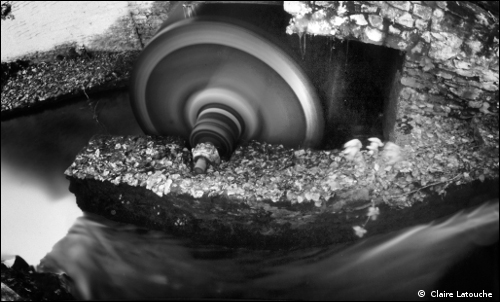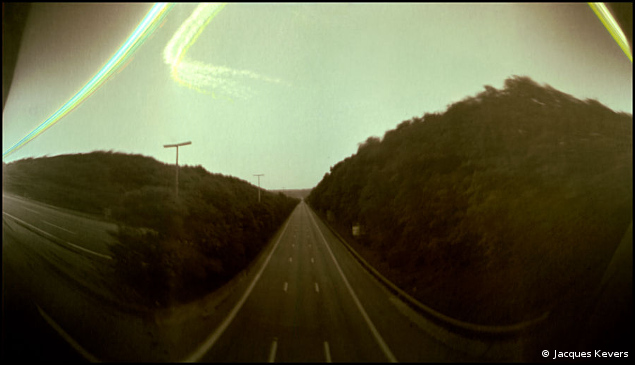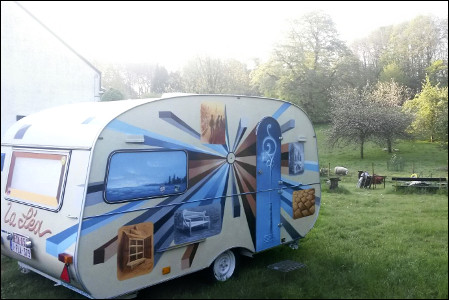Pinhole Photography

Pinhole is not a printing process similar to the other processes presented on this website: gum printing, salted paper, platinum printing, etc..
It is a device allowing to project an image on a surface that is light sensitive, or not.
Why dealing with it here, then?
- Because just as with the above mentioned techniques, its practice involves a good deal of manual skill on the part of those – most of them – who want to build their own devices
- Because the obvious limits imposed by the rudimentary nature of the device are an excellent stimulus for creativity
- Because the characteristic aesthetics of the images made with this type of equipment harmonize perfectly with the old photographic processes
- Because the pinhole revival, started some 40 years ago, has its origin in the search by a number of artists of a different, “alternative” photography..
- Because it is a simple and inexpensive way to get acquainted with many basic photographic principles: light intensity, angle of view, depth of field, exposure time to relative aperture relationship, etc. ..
We are not aiming at a comprehensive survey on the question; An internet search, or the links at the bottom of this page will provide you with all the information you would like. This page is simply intended to honor a type of photography which, although widely practiced, is still insufficiently appreciated, being often considered with a little condescension as a simple and funny child's play. With few exceptions, their practicioners remain relatively unknown, away from art galleries, business circuits and fashion trends.
The origins
As early as in the 5th century BC, the projection of an exterior image on the wall of a darkened room through a small hole in the opposite wall was described
by the Chinese philosopher Mo Ti.
It was not until the third century BC that in the West Aristotle asked why the sun, passing through a square hole, projected a round image. This question,
known as “Aristotle's problem” found an answer in 1521, in Franciscus Maurolycus's book “Photismi de lumi and umbra”.
In Africa, the Arab mathematician and physicist Ibn Al Haitham observed in the 10th century that the sharpness of a projected image depended on the size
of the hole the light was passing through.
With these and several other works, Leonardo da Vinci was able to record the first precise description of a “camera obscura” in his Notebooks in 1502.
Pinhole and photography
One might think that those rather crude pinhole cameras were the first devices to be used in photogaphy. Not so. The “Camera Obscura” of
Giovanni Battista della Porta in the 16th century as well as the one of Johann Zahn in the 17th, were already equipped with lenses. The first steps in photography
(“invented” in 1839) were made thanks to lens objectives. The use of the pinhole in photography only appeared later.
The lens objectives were not used to improve a relatively mediocre sharpness of pinhole images , but above all to improve the luminosity of
the images projected in the camera. Many scientists have very quickly sought – and found – mathematical formulae to determine the optimum
diameter of the pinhole, in order to obtain the sharpest image possible. This was the case of Joseph Petzval in 1857. And of Lord Rayleigh in 1889, who wanted
to use the pinhole in astronomy, and ended up defining a formula which, according to his statements, made it possible to produce images of a definition
equivalent to that of the images formed on our retinas. This formula is still used today. It is not the only one. Over the last 145 years of the pinhole photography
history, more than fifty formulas, all slightly different, have been proposed. And photographs of surprising sharpness were realized. That said, sharpness certainly
is not the first quality sought after by pinhole fans...
Toy, educational tool, social instrument ... or art?
In fact, pinhole photography is a bit of all of this at the same time.
It is playful. It does not require expensive equipment or cumbersome installations. You can make your own device from everything and anything: a bucket, a
garbage can, a film box, or even a pepper ... the limits are those of your imagination. The absence of viewfinder, the effect of long exposures which can be
counted in minutes or even in hours, the deformations caused by unusual forms of the bottom of the “box” result in surprising, unexpected images
that are revealed in the darkroom. An accessible activity thus, and a pleasure.
But it also allows for learning all the basic principles of film or digital photography; it is an unparalleled school of patience, observation, creativity. No
wonder that this activity has given rise to countless pedagogical workshops ...
In total breaking with the current practice, this way of photographing allows everyone to re-invent his own language. To reconnect poetically with a raw,
unprepared approach to the image. To re-examine our relation to time, to instantaneity, to reality. To expand the field of our sensations, our emotions, and
to translate the volatility of the world.
It is therefore not surprising that in the mid-1960s, after an eclipse of about twenty years, a certain number of artists – not necessarily photographers at the
beginning – began to explore its possibilities again, and to develop an interest in its particular aesthetics and philosophy. Their motivations have been quite
diverse.
Some saw it as a means of asserting their affiliation with Pictorialism, which gained renewed interest in the 1970s, and choosed to combine pinhole
and old photographic processes – cyanotype, gum printing, platinum prints, etc.
The pinhole camera allowed them also to make the big negatives needed for these contact printing processes.
Others were attracted by the experimental side. Deformations, random framing, internal reflections or outdated sensitive surfaces with unpredictable
behavior: everything is good for those who seek the unexpected, the unplanned, the surprises of the “providential failures”.

Currently, the “solargraphy” fans expose photographic paper outdoors for a few days or months and record the sun's travels in the landscape, but
also a series of unexpected phenomena: strange colors due to long exposure, odd shapes caused by the changes in temperature and humidity... All this produces
ephemeral images which can not be developed nor fixed, and which have to be scanned or rephotographed to keep track of them ... unless the pinhole box
disappeared before the end of the experiment! A summit of "slow photography" ...

(Author's note: unlike what is said above, and what is found in many publications, I was able to fix the "negative" without any problem: the image first completely disappeared in the fix, to come back after rinsing, drying, and exposure to light. A stroke of luck? Or? It's up to you to conduct your experiments, starting with scanning the negative as a precautionary measure... J. Kevers).
Finally, some use pinhole photography as an instrument of dialogue, as a way to overcome cultural diversity and to reinforce social cohesion. Atelier Graphoui
for example just had their project accepted by the Brussels Capital Region to go and meet the inhabitants of different populous city districts with a
pinhole-caravan used as a portrait studio. Their caravan becomes a laboratory of initiation to different expression modes, and an ultimate encounter laboratory.
Technical aspects – formulae
I will not dwell on these aspects. You will find elsewhere in the technical section of this site tips for the construction of a pinhole (the “hole”), an example of the different formulae involved in the construction of a pinhole camera applied to a specific case, and a “Pinhole Calculator” presented in the form of an Excel spreadsheet. The formulae and calculator were found on the internet, adapted, and published here with the agreement of their author. Remember, however, that there are many different formulae! Do not forget that the regularity of the hole and the cleanliness of its edges are at least as important for the quality of the image as the precision of its diameter ...
| Measured/calculated | Compensating factor | Corrected time |
|---|---|---|
| 1 s. | x 1,25 | 1,25 s. |
| 5 s. | x 1,5 | 7,5 s. |
| 15 s. | x 2 | 30 s. |
| 45 s. | x 2,5 | 135 s. |
| 2 min. | x3 | 6 min. |
| 5min | x4 | 20 min. |
| 10 min | x5 | 50 min. |
| 20 min | x6 | 2 h. |
| 40 min | x8 | 5h20 |
Keep in mind that for long exposures, the Schwarzschild effect must be taken into account: under 1 / 1000th sec and beyond 1 sec, sensitive
substrates react less quickly to Increases / reductions of exposure time, and a compensating factor has to be applied.
The importance of this compensation depends on the media type (paper or film), and its brand.
The results obtained by theoretical calculation will therefore only give a starting point, to be interpreted according to your personal experience.
As a guide, you will find a list of suggested compensating factors, to be adapted according to your own experiences
| # | Diameter | # | Diameter | # | Diameter | # | Diameter |
|---|---|---|---|---|---|---|---|
| 1 | 1,17 mm | 4 | 094 mm | 7 | 0,69 mm | 10 | 0,46 mm |
| 2 | 1,09 mm | 5 | 0,86 mm | 8 | 0,61 mm | 11 | 0,42 mm |
| 3 | 1,02 mm | 6 | 0,76 mm | 9. | 0,53 mm | 12 | 0,35mm |
Most pinhole photographers use pins / sewing needles to drill the pinholes they need. These needles / pins are characterized by a number related to the diameter. The higher the number, the finer the needle. Again: the regularity of the hole is more important than the precision of the diameter ...
For even finer pins, look for acupuncture needles: 0,30 - 0,25 - 0,20 or 0,15mm needles are available ...
Documentation
Links- www.galerie-photo.com/stenope.html : La photographie au sténopé by Robert Colognoli (in French)
- benmh.nl/pinhole-photograpy : pinhole calculator & camera build (English/Dutch) - by Ben Mossing Holsteijn
- beertjesfotosite.be : Beertjes Photo site - pinhole photography (Dutch)
- alternativephotography.com : All about pinholes...
- jongrepstad.com/pinhole-photography : Jon Grepstad - History, Images, Cameras, Formulae...
- www.pinhole.cz : David Balihar's quite comprehensive site.
- Alexandra Cool: Moments of Writing/ : Pinhole pictures (Dutch - French - English - German) )
- www.ilanwolff.com/fr/ : Ilan Wolff, pinhole photographer
- www.legacyphotoproject.com/ : the largest pinhole in the world...
- pinholeday.org/ : Worldwide Pinhole Photography Day
- Le sténopé – J-M Galley & E. Towns – Collection Photo-Poche n°114 ; Actes Sud, 2007. ISBN 978-27-427-70151
- Les pratiques pauvres: du sténopé au téléphone mobile – Jean-Marie Baldner & Yannick Vigouroux
Scéren-CNDP, Pôle photo, Isthme éditions, Paris, 2005. ISBN 978-29-126-88477 - Pinhole photography - Rediscovering a historic technique – Eric Renner – Focal press 1995 ISBN 978-02-408-02374
- Moments of writing – Alexandra Cool – Lannoo, Tielt 2010 – ISBN 978-90-209-94544
- Les boîtes à rêves, ou comment construire facilement son sténopé – Christian Carez – (Kindle format)

